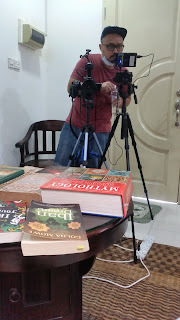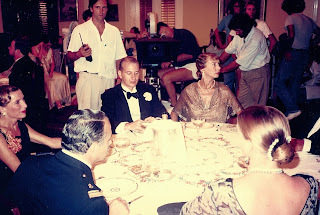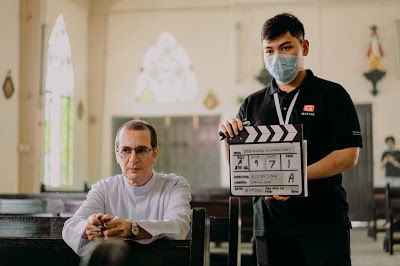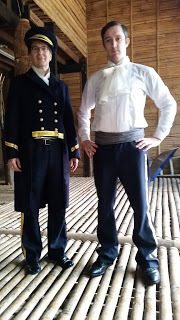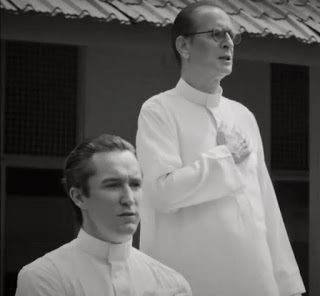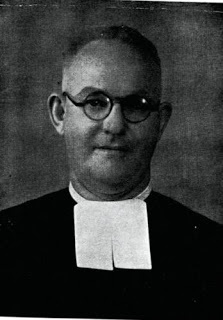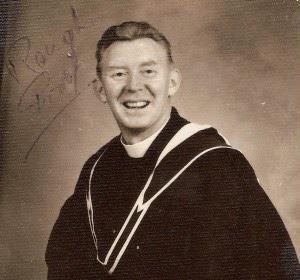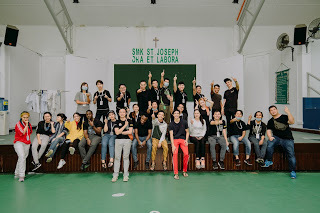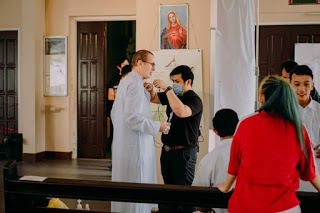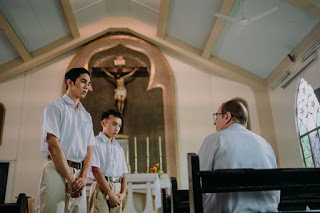Robert Raymer's Blog, page 2
October 10, 2023
Being Seen on TV by a Friend
“You’re on TV!” my wife told me over thephone, calling from a Toyota dealership where she was having her car serviced. A friend of hers had texted that she waswatching me on TV. I soon realized that it was a repeat of the Past Present Future Episode 5: Writing Natives episodeon TV Sarawak that featured Golda Mowe, author of such novels as IbanDream, Iban Journey and Iban Women that I hadblogged about.
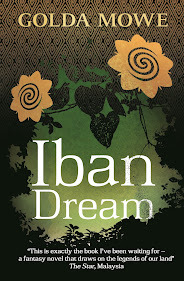
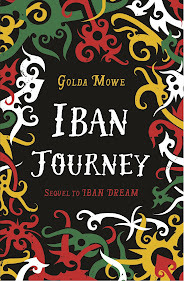
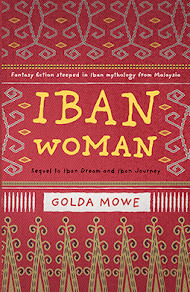
After interviewing Golda a few years ago, I had been asked to take part in a documentaryabout her writing life. The filming for my part wasdone at my house, which made it convenient. Unfortunately, I missed the actual programbut I was glad that at least someone I knew watched it (or a at least a repeatversion of it).
I told my wife to let her friend know that I would be available for autographs. I’mstill waiting…
—Borneo Expat Writer
My other Interviews with First Novelists:
Ivy Ngeow author of Cry of the Flying Rhino, winner of the 2016 Proverse Prize.
Preeta Samarasan, author of Evening is the Whole Day, finalist for the Commonwealth Writers Prize 2009.
Chuah Guat Eng, author of Echoes of Silence and Days of Change.
Also, Malachi Edwin Vethamani, author of Complicated Lives and Life Happens.
Five part Maugham and Me series
February 9, 2022
Sarawak Author Golda Mowe Featured in a Documentary
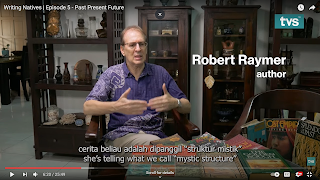
Congrats to Golda Mowe on being featured on Past Present Future Episode 5: Writing Natives, which aired 4 August 2021 on TV Sarawak (TVS).
Having come across my author-to-author interview with Golda, Deborah Christopher, who studied Cinematography at Universiti Malaysia Sarawak (UNIMAS) where I taught for a number of years, asked me if I was interested in being interviewed for a documentary featuring Golda Mowe. Golda, from Sarawak, is the author of the novels Iban Dream, Iban Journey and Iban Women.
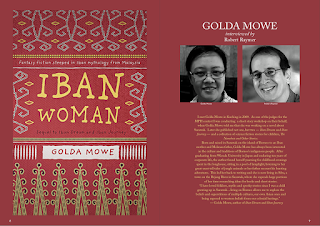 Blue Lotus 15
Blue Lotus 15
Deborah is the co-producer for a documentary series named Past, Present, and Future, a project funded by TVS. Each episode highlights different stories of Sarawak personalities who have incorporated their culture and traditions from the past into their present (and future) careers or projects.
I was glad to hear that Golda Mowe was being featured since she is underappreciated and deserves a wider audience. I was impressed by her discipline, her persistence and her willingness to rewrite. Many Malaysian writers do not seem to want to put in the extra work, thinking it is good enough for Malaysia. The good ones, like Golda and others that I have interviewed who want to attract an international audience, know better.
Due to the on-going pandemic, the project was delayed. Then last year the film crew nearly got locked down in Sibu while interviewing Golda. Meanwhile, I made a list of things to do before the filming: reread Iban Dreamand purchase and read the other two novels in the series; prepare for the interview by coming up with something interesting to say; make notes, reminders of what I need to do the week and the day before the shoot (including domestic chores—sweeping, dusting, cleaning the living room); and more reminders for the morning of the shoot itself (arrange mythology books on table, make sure I have handy everything I may need—water bottle, pen and notebook, outline of my talk in case I go blank.

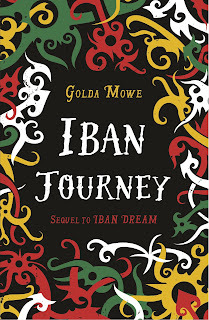
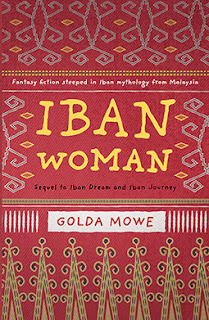
After reading Golda’s three novels, I learned a lot about Iban myths, their fears and dreams, their omens and taboos, their customary laws (cannot refuse a visitor if he makes a request to stay at your longhouse and cannot refuse food offered to you), the significance of weaving patterns (and the harmful risks of trying to weave above your skill level) and also retribution, an obligation to take avenge if one of your relatives was killed. Also, that the ideal matrimonial match should be between a feared headhunter and a gifted weaver.
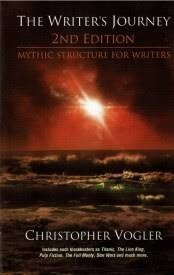
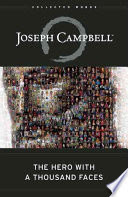
For the documentary I was asked to talk about Golda, her writing, and her life journey, which got me to thinking in terms of The Writer’s Journey, Mythic Structure for Writers, a book by Christopher Vogler, which I picked up at a writing conference in Maui, along with a companion book, Myth and the Movies, Discovering the Mythic Structure of 50 Unforgettable Films by Stuart Voytilla.
Vogler, inspired by the work of Joseph Campbell, author of Hero with a Thousand Faces, discusses the use of archetypes such as the Hero, the Mentor, the Threshold Guardians, the Herald, the Shapeshifter (gods and demons), the Shadow and the Trickster. Also the Mystic Structure and Stages of the Journey: Ordinary World; Call to Adventure; Refusal of the Call; Meeting with the Mentor; Crossing the First Threshold; Tests, Allies, Enemies; Approach to the Innermost Cave; Ordeal; Reward (Seizing the Sword); The Road Back; Resurrection; Return with the Elixir.
This mystic structure can be applied to nearly every story from adventures to romance to slapstick comedy, even to animation such as Disney’s The Lion King.
To prepare myself for the documentary, I broke my presentation into four parts: (1) Golda’s use of mythology; (2) her plots and themes; (3) her personal writer’s journey and how we met (MPH workshop that I conducted in 2009); and (4) her writing in Sarawak and publishing in Singapore. I had written a blog about publishing books in Malaysia and Singapore.
A common theme in all three of Golda’s novels is the hero being made a scapegoat or an outcast—you against the world (both visible and invisible). The hero, even as a child, is often forced to undertake the ‘hero’s journey’, like Tarzan, or Mowgli in The Jungle Book, or Simba in The Lion King, often cast out unfairly by society. In Golda’s Iban Dream, the child Bujang, is raised by an orangutan…destined to be a great warrior. All three novels are connected by a cursed family line and each hero/heroine sets out to prove that they are notcursed, to right wrongs.
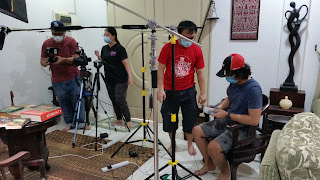
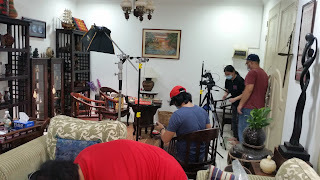
Deborah and Jeremy Emang (the producer and director), along with the rest of the crew, Shawn and Elisha, arrived at my house for the half-day shoot. They proceeded to set up the camera and lights and the rest of their equipment in one section of our living room, aimed at me sitting at a round table and with several coffee table books on mythology and lost cities, lost empires, including Homer’s The Iliad and The Odyssey, with a nice backdrop of collected items from my travels.
Once the filming began, I proceeded to talk about Golda’s personal hero’s journey as a writer and her own mystic journey, some of which I had learned from my research from my previous interview.
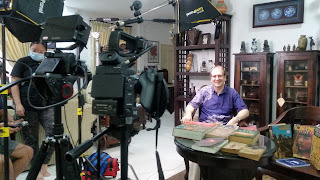
Then I spoke about the hero’s journey within her stories and how it dates back to ancient Greeks, which she, coincidentally talked about during her own segment. When most people think of mythology, they often limit themselves to Greek and Roman mythology, dating back to the Trojan War. But every culture has their own mythology, and Golda Mowe wrote about the Iban mythology that is important to her. She writes about what she knows, what she has learned, and from her meticulous research to get the details of her rich Iban heritage correct. It’s these details that make her fantasy novels palpable. As a reader, we are caught up in their journeys, their quests, their battles with demons and headhunters.
I continued to talk until I heard an all too familiar jingle from an ice-cream truck. Knowing that sound equipment for the filming could pick it up, I took a much-needed break and drink of water. We waited several minutes until the vendor made his rounds and took away his jingle.
I picked up where I left off and continued to say what I felt needed to be said on Golda’s behalf. I had done my homework and was well prepared. After the interview, Jeremy told me that he had written a list of questions but I had answered all of them as I spoke, so there was no need to interrupt me. He could relax, check off each unasked question, and concentrate on the filming.
A few weeks later, Deborah contacted me to borrow my three Golda Mowe books for another shot (since Golda was still in Sibu) and promptly returned the books. During the actual documentary, I appeared four times; however, I was bleeped only once. What I said was the right word for the context (bullsh…ing). I thought they would cut it from the actual documentary. Instead, I have my first recorded ‘bleep’ caught on film, a badge of honor.
Although I didn’t get a chance to meet Golda again, it was good to see her on film. Since she did all the hard work, the research and writing her books, she deserves all the credit for her well written books about Ibans in Sarawak. I wish her all the best with her writing and hope she continues her hero’s journey that all writers must undertake if they dare to dream and write and see their work published.
—Borneo Expat Writer
My other Interviews with First Novelists:
Ivy Ngeow author of Cry of the Flying Rhino, winner of the 2016 Proverse Prize.
Preeta Samarasan, author of Evening is the Whole Day, finalist for the Commonwealth Writers Prize 2009.
Chuah Guat Eng, author of Echoes of Silence and Days of Change.
Also, Malachi Edwin Vethamani, author of Complicated Lives and Life Happens.
Five part Maugham and Me series
September 4, 2021
A Final Farewell to a Tango Dancer
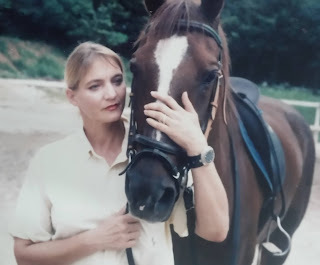
I originally wrote this article “Farewell to a Tango Dancer” in 2003 for a farewell dinner for Anni Nordmann before she left Penang, Malaysia where I first met her, and later published a revised version for Tropical Affairs. Having learned that she had recently passed away due to cancer, I thought I would post the article as a final tribute to Anni.
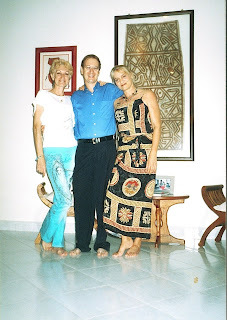 Joelle, Robert, Anni
Joelle, Robert, Anni
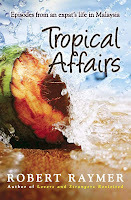 If expats are good at one thing it’s saying goodbye because we do it so often—to expats leaving and those staying behind. Expats come in two types: those who come to a country for a year or two before moving onto the next country, and those who come to one country and stay put. Anni Nordmann was both. She had been an expat in eight countries—South Africa, Zimbabwe, Switzerland, Gabon, Thailand, Indonesia, Hong Kong, and Singapore—before arriving in Penang, Malaysia where she ended up staying for sixteen years.
If expats are good at one thing it’s saying goodbye because we do it so often—to expats leaving and those staying behind. Expats come in two types: those who come to a country for a year or two before moving onto the next country, and those who come to one country and stay put. Anni Nordmann was both. She had been an expat in eight countries—South Africa, Zimbabwe, Switzerland, Gabon, Thailand, Indonesia, Hong Kong, and Singapore—before arriving in Penang, Malaysia where she ended up staying for sixteen years. After being away from the United States for 28 years, she’s finally returning home. Like other long-stayers-in-one-country expats like myself, I was wondering, how do you say goodbye to a fellow expat whom you thought would never leave?
Like Anni, when I came to Malaysia20 years ago, the intention was never to stay for very long, but as years went by, I became settled. Initially I was awed by those long-time expats who had been here for ten or twelve years, and thought, how do they stay that long? Don’t they miss their families and friends back home? But as the years went by, as we started our own families here, this becomes home,
Although I moved to Penang in 1985, Anni came in 1987 with her Swiss husband and three-year old son, Chris. Later we discovered that before we met, our paths had crossed several times. Anni was living in Holiday Inn, where her husband was the general manager, and I had been to the Holiday Inn on many occasions, attending various functions, including a Thanksgiving dinner for Americans where she was also present. My ex-wife and I were close to Stella, Holiday Inn’s guest relations officer, and attended her wedding, as did Anni. In 1991, after four years, after Anni had already left Holiday Inn, after her husband had moved away to another hotel in another country, we finally met.
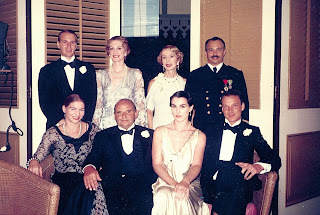
During the filming of Indochine, starring Catherine Deneuve and Vincent Perez, which won an Oscar for Best Foreign Language Film, the director decided to do a day shoot instead of a night shoot for the Christmas Dinner scene, thus several male expats had to back out as guests and tango dancers. So the casting people called me as one of the replacements.
Before the actual filming of the scene, all eight tango dancers met in Hotel Equatorial with the film’s choreographer. In walked Anni, a classy looking American who played polo and taught horseback riding. Anni, however, was not fated to be my dancing partner. Instead it was her good friend Joelle Saint-Arnoult, another longtime expat from France. For one week we learned how to dance and turn and dip to perfection.
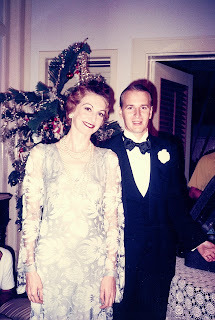
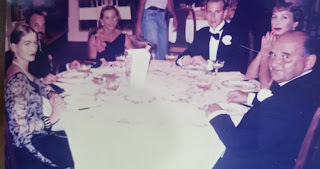
Our Christmas Dinner scene in the old Crag Hotel atop Penang Hill took four days to shoot. Elegantly dressed in period outfits from the 1930s, Anni sat directly across from me, so we had plenty of time to get to know one another. A few weeks later, Anni, Joelle and I were invited to take part in the racing boat scene in Parit, Perak.
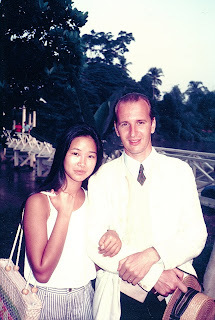 with Lind Dan Pham
with Lind Dan Pham After Indochine,all three of us were extras in Beyond Rangoon—also set in Penang—directed by John Boorman, starring Patricia Arquette and Francis McDormand, and Paradise Road, directed by Bruce Beresford, starring Glenn Close and Cate Blanchett. In Beyond Rangoon, Anni and I worked a few days in wardrobe when they needed extra help to deal with 2000 extras, where we gained a whole new perspective into movie making.
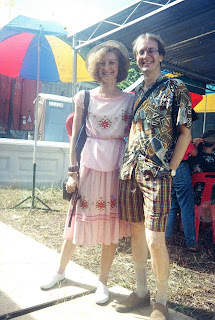
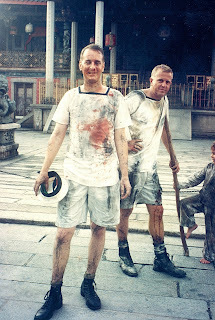
In 1992, Anni, Joelle and I were asked by Angela Clark another tango dancer from Indochine, to help revive Penang Players after a twelve years hiatus. Our first play was Admirable Crichtonwhere Joelle and Anni had small acting parts. Anni’s big part was sound effects, and I was stage manager. Our behind-the-scenes roles continued for several productions including, Gosforth’s Fete, Between Mouthfuls, The Mousetrap, and Dick Whittington and Wonder Cat. Joelle played the Wonder Cat and Anni’s son Chris, then age 10, played Dick Whittington.
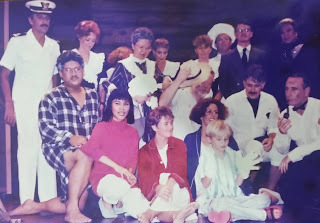
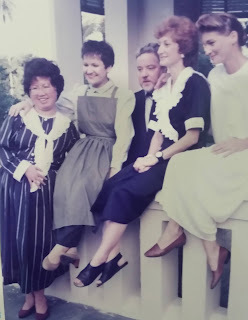
During this time, Anni and I shared other adventures, too. She helped to dress me up as Santa Claus for St. Christopher’s School, where her son Chris was attending. Thanks to Indochine, we became models for Hotel Equatorial, City Bayview, and Bacchus, a French restaurant owned by Joelle and her husband. We were then hired to dress up as Colonial Officers and their spouses at the E & O Hotel for 200 French Lotto winners.
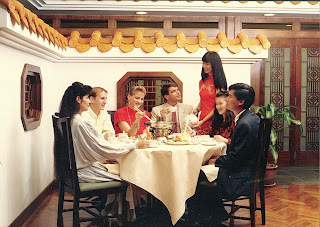
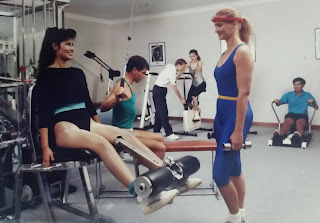
For the Penang Heritage Trust’s Twenties Revival at the former Runnymede Hotel, we were asked to reprise our roles as tango dancers from Indochine and put on a performance. By then, the eight tango dancers in Penang had dwindled to five.
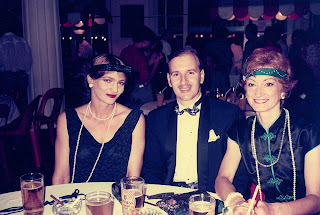

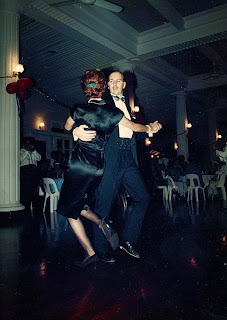
Anni and I shared a penchant for visiting places where we didn’t belong, like the remnants of a house in Batu Ferringhi where another long-term expat-cum hermit named Bill McVeigh was still living out the remainder of his life before he passed away. We snuck into several abandoned bungalows, including one where we were chased by bats, and another time, I tore my shirt slipping through a hole in a fence.
There were sad moments too, like giving blood to a fellow Penang Player who later died of cancer; although he was from Penang, he was a long-term expat in France. Anni, at her own personal risk, once helped another expat flee Penang from an abusive husband.
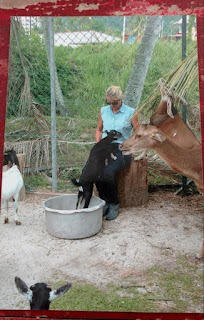
In the last five years, Anni devoted herself to “The Farm” at Lone Pine Hotel, where she taught horseback riding, resurfacing now and then to do the sound for yet another Penang Players’ production. Meanwhile I settled to a life teaching creative writing at USM, went through a divorce, and eventually met someone wonderful from Sarawakand remarried.
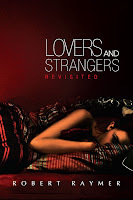
While I concentrated on teaching and my own writing, Anni offered to read an early draft of my novel and gave helpful feedback. Over the years she had edited two more of my novels and some short stories. Extremely supportive of my writing, she, Joelle and others from Penang Players volunteered to launch my collection of Malaysian-set short stories, Lovers and Strangers. Later they did again for the revised version, Lovers and Strangers Revisited. By then Anni had left, although I acknowledged her in the book.
When Joelle first told me that Anni was leaving Penang, I contacted her and we quickly caught up with each other’s lives, reminiscing about all the adventures we had shared in Penang, as well as airing each other’s concerns about her returning to the US and her future life as a former expat whose heart will always be in Malaysia where she had spent a third of her life. When I was going through a difficult custody battle for my son, she gave me the timely advice to “keep your head high”. I know she will be do the same no matter what happens in the US where many fellow Americans have never traveled out of the US, other than weekend trips to Mexico or Canada, and have no desire to do so.
Like many other short- and long-term expats in Penang, as well as hordes of local friends, especially those in Penang Players or from The Lone Pine—we will miss Anni, particularly Joelle and I, who will remain behind in Penang as the last two tango dancers.
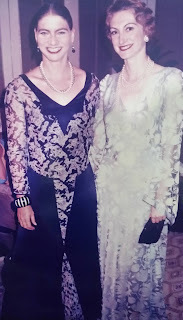
*Later,
in 2006, I left Penang for Sarawak on the island of Borneo in East Malaysia where I still reside as an expat. Joelle remains in Penang.March 17, 2021
“The Stare” Published in Thema (Spring 2021)
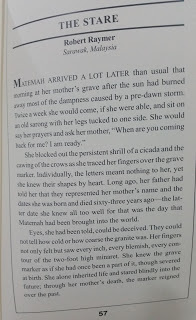
My short story “The Stare” was published in Thema (Spring 2021) in the US. The story was first published in New Straits Times in Malaysia back in 1986. That’s 35 years ago, so I guess it has a timeless quality about it. I got the idea after visiting an old Malay cemetery and wrote about it in Story Behind the Story. This is the fifth short story published in Thema, four from the Lovers and Strangers Revisited collection.
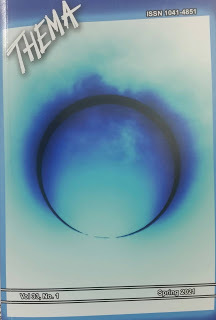
October 18, 2020
Being Brother Patrick of St. Joseph in Abdul Taib Mahmud: An Untold Story-Part II
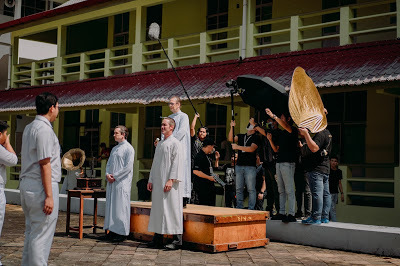
After filming at the chapel at the Carmelite Monastery (see Part I), both the school assembly and class photo scenes at St. Joseph Secondary School were switched to Sunday, the final day of filming. All the extras—Garret-another Brother, Leslie-the photographer, and about three dozen Form Five students from St. Joseph—were brought it for the shots.
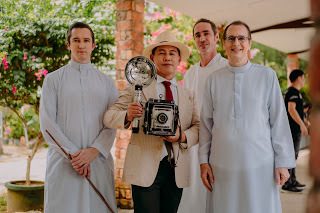
There was some drama in the school assembly when the Taib and Annuar characters arrived late and Annuar collided with Brother Charles who was wielding his cane. My opening lines addressing the school assembly went well, just needed to work on the cadence. The tiles, however, were slippery from the early morning rain for my dress shoes, so I had to be careful while walking and then climbing onto the platform (they had to remove the makeshift steps which were even more precarious).
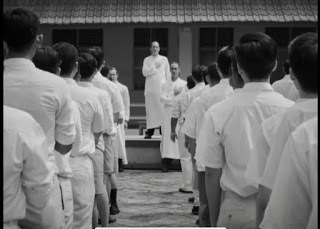
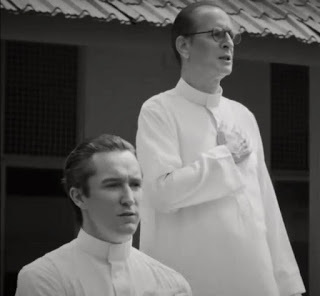
While waiting for the class photo scene, I ran into Donjie, the kantung seller, who Alex and I knew from Road to Nationhood: Sarawak.
 Donjie
Donjie 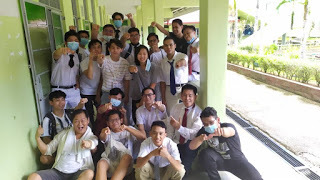
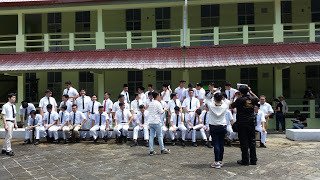
By the time the class photo sequence was ready to begin, the sun was directly above our heads and we were all melting. Although I acted cool, the bald spot in the back of my head could feel the heat.

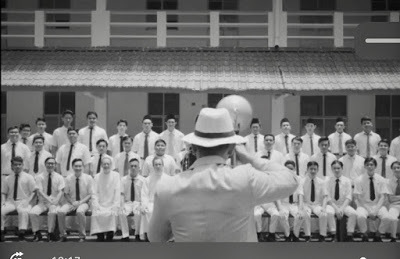
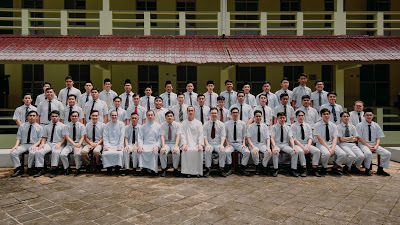 Taib's Class Photo 1955
Taib's Class Photo 1955I thought we were done, but we were called in for an ADR—Additional Dialogue Replacement—to dub in lines that weren’t clear on the film for a variety of reasons, some out of our control like that passing ambulance. I immediately dreaded redoing the school rally, something I was still singing inside my head, and desperately wanted out! Then I figured, since they were no longer filming, I could read from the script, so no problem. No, the school rally was fine and the close-ups on me were at the beginning before I had time to mess up.
We arrived at Momentum Studio Thursday evening. Since I had the longest drive home, and it was a school night and I had to be up at 5:15 a.m. the following morning, they let me go first.
“Are you ready?” asked Amos as he led me to the sound room.
“When have I ever not been ready?” I replied jokingly.
My wife would’ve laughed at that. “Now what?” she would say, after another delay whenever we were rushing anywhere.
“Wait,” I told Amos, “I forgot my backpack…”
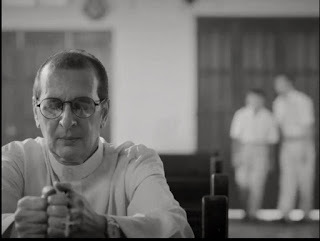
On the monitor was me from the church scene, kneeling in my pew. I needed to redo the prayers. Bernie keyed me in with a series of three beats. On the fourth non-existent beat I would begin. It was weird speaking to myself, trying to match the words with the lips that were moving in front of me. All I had to do was say my prayer a couple of times and then I silently prayed it would be over before they changed their minds about redoing that song.
One month to the day of my audition to play Brother Patrick I happened to be in Sibu when I heard that Sarawak TV would be airing our film that evening; however, they weren’t sure of the time, anywhere from 7:30-9:30. The hotel didn’t carry that channel, but I was told it could be watched live online.
We watched the news at 7:30, and kept glancing at the time as the program, a tribute to Taib Mahmud dragged on…a variety show of speeches, singing and dancing that culminated with the presentation of our film by Pixbugs Studio—his special birthday present—at 10 pm! By then both of our boys were sound asleep. Nevertheless, my wife and I watched the program on her phone in bed. Luckily, it didn’t put us to sleep.
Here is a link to the 15 minute video:
https://drive.google.com/file/d/1Wagk...
What really jolted me awake was the first shot of me—a closeup of the balding spot on the back of my head as I stood on the podium about to address the school assembly. It was not a good look. Shocking to say the least since I never see that particular angle when I look at myself in the mirror, nor do I want to see it, let alone millions of strangers. Other than that, the film was nicely done, shot in black and white in a nostalgic style befitting Malaysia in the mid-50’s. For Malaysians, think P. Ramlee.
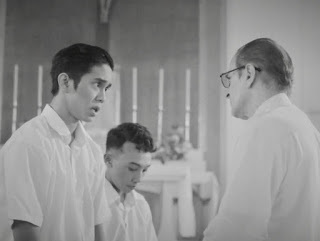
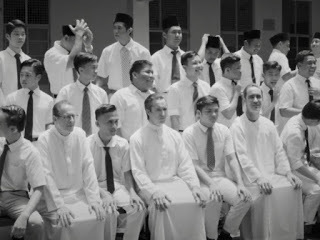

Beheaded on the Road to Nationhood—Part I
Beheaded on the Road to Nationhood—Part II
Somerset Maugham and Me—Part I-V
Joseph Conrad and Me
October 17, 2020
Being Brother Patrick of St. Joseph in Abdul Taib Mahmud: An Untold Story-Part I
Alex passed the phone to Michele who works for Film Makers Company who in turn was hired by Pixbugs Studio, in charge of Production, to do the casting and wardrobe. She informed me that auditions would end in a few days, so I made an appointment for Thursday afternoon. I dropped off one of my sons at St. Joseph Secondary School, slipped on my Covid-19 pandemic face mask and arrived at their office.
After filling in my personal details and measurements, Michele passed me my lines. A lot of lines. I had a moment of panic. Although I have been an extra in four feature films, including Indochine, which won an Oscar for Best Foreign Language Film, I’ve never had to interact and exchange lines with other actors before (not even in plays, although I’ve been a stage manager for several Penang Players productions).
I did take part in two French documentaries, one on Somerset Maugham and the other Joseph Conrad. For both projects, I extensively researched my subjects and expounded upon what I had learned, their ties to Sarawak.
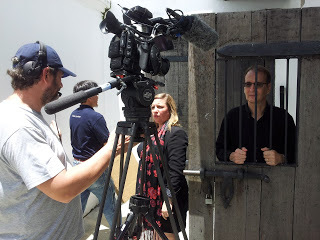
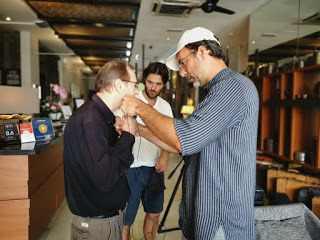
Exchanging dialogue with another actor is quite different. You have to listen closely, react accordingly, and speak your lines on cue. The church scene was a very long dialogue sequence between Taib and Brother Patrick at a crucial junction in the film.
Not sure I was up to it, I considered bailing on the project, but Sam, who was Michele’s boss, came over and gave me a pep talk and encouraged me to try out since I was there. Due to Covid-19 there weren’t that many expatriates in Kuching in my age category who could (or wanted to) act. Ok, so maybe they were desperate.
Michele gave me some time to memorize my lines. She then filmed me as I stated my name, age, height, and previous acting experience. I then had to act out four emotions: Happy, Sad, Angry and Excited.
“Have you ever done this before?”
“No,” I replied, but found it fun. The less fun part was remembering my lines which I kept flubbing, even skipping whole paragraphs, but eventually I got the hang of it. After a few takes they convinced me that I did fine.
At home, I still contemplated bailing since I was in the middle of a long writing project and didn’t want to break my momentum. Then I figured someone else would get the part. That didn’t happen. Late Friday, I got the call. I was in. So was Alex.
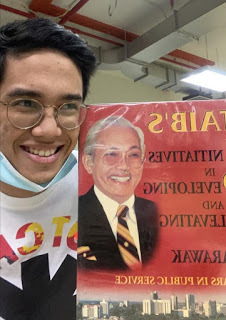
Jocelyn-Art Director and Melissa-Makeup Artist studied my face—an unnerving experience having two young ladies conferring back and forth on the flaws of my face up-close and personal and what they would need to do to make me look more like Brother Patrick since a total facelift was out of the question (and out of their budget). Alex got the same treatment.
Rehearsals went well since we could look at our scripts if necessary. The school rally song went horribly wrong. Some of the students knew it by heart, the rest of us were clueless. Someone found the music and the words on YouTube, so we tried to follow along. Later I asked my son if he had a copy of the school rally and he passed me a notebook that had the words on the back, so I cut it out and kept a copy in my car. Turned out there was more than one version, so I had to amend it accordingly.
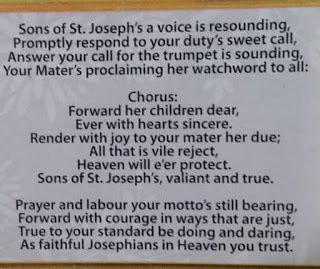
A Taib Production Talent group was set up on WhatsApp to keep us informed of production details and shooting schedules. Plus, a second group, Cast for Untold Story, to ease communication between the director and the principal cast, which included updated copies of the script and video references for the main characters so they could see the facial expressions and mannerisms of those whom they would portray.
I suggested a few editing changes in my lines to improve emphasis, which were readily accepted and caused additional updated scripts. Alester and Bernie were very accommodating.
Filming would take place on Wednesday, Sarawak Day, at Carmelite Monastery, and then on Saturday and Sunday at St. Joseph. By Tuesday most of the lines that I had memorized got changed. They were changed again when we were handed the new script on Wednesday.
I was told to bring black shoes, not to wear my wedding ring, and was given a pair of round glasses, which made it difficult to see, but gave me a rather nice Harry Potter look.

No one said anything about a white t-shirt to wear underneath the white cassock. For some reason I thought the cassock would be dark…burgundy perhaps. Luckily, they had a spare t-shirt. Later, I realized that I had overlooked that detail buried within all the other messages. I then brought a spare t-shirt for Garrett, another Brother involved with the Sunday shoot, who was under the impression he was to wear a white dress shirt, not a white t-shirt. Miscommunications happen.
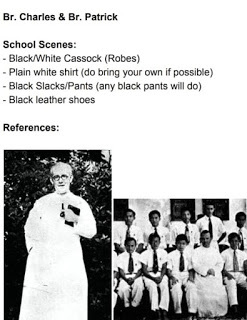
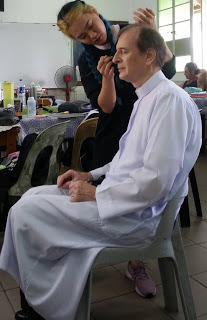
Melissa slicked back my hair and did the makeup. Meanwhile Ezmir and I ran through our lines. Once we were ready, we were driven to the set, to the chapel at the Carmelite Monastery. For the shoot that morning there was only three actors, but 30 for production! Most were from Pixbugs, some from Film Makers, others were freelancers.
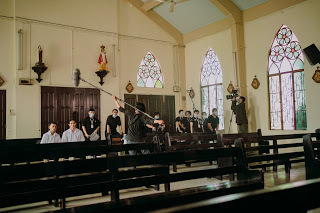
While they filmed the two students shyly entering the chapel, sitting on a back pew, and then making their way up the aisle towards my character, I had plenty of time to go over my lines. Sam from Film Makers dropped by and told me that he was glad that I got the part, which made me feel good. I didn’t ask how many others I had beaten out just in case I was the only one. (I think there was one other person who came in second place…Covid-19, what to do?)
Later, I found a secluded place in the monastery so I could practice rising from a seated position and saying my lines—out of eyesight and earshot of everyone else. Or so I thought. Suddenly a door opened, and I found myself face to face with an elderly nun who gazed suspiciously at me dressed in a cassock. She said she heard someone talking and thought I needed to be let in. I apologized for disturbing her and explained my presence. I hoped that I had her blessing and not a curse for disturbing her peace as I went back to rehearsing my lines.
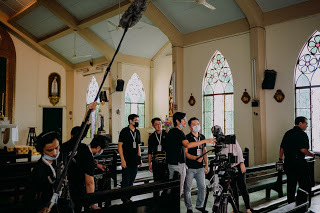
Finally, I was allowed inside the chapel and guided to the second pew and briefed. For effect, smoke was created by waving a carpet, which added to the stuffiness inside. With the cameras rolling, I would start by kneeling, then I would sit back in my pew. Two students would appear at my side.
Surprised at seeing them, I would stand to greet them and then listen to their formal request to leave classes early on Fridays to attend prayers at the mosque.
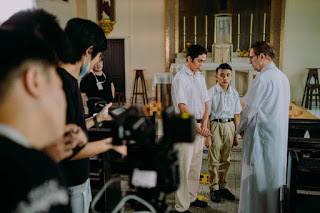
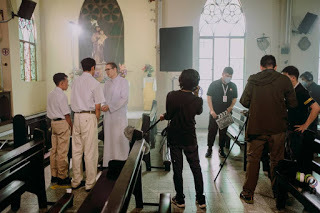
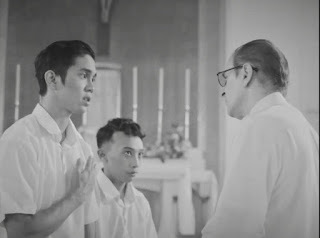
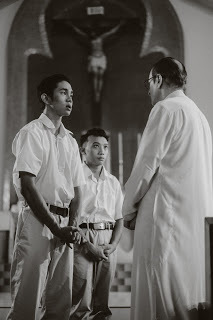
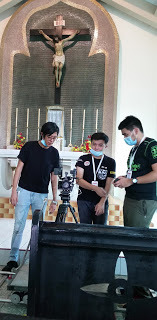
Occasionally they would forget to let me up while they conferred on the various takes, adjusting the prayer beads, and making sure that the cross draped over my hand appropriately. I felt the pain in my knees and lower back since I was kneeling in an awkward angle to get the right height among the pews for the cameras, which were moved to various positions. I was perspiring from the strain, which the director noted and duly apologized.

 Beheaded on the Road to Nationhood—Part II
Beheaded on the Road to Nationhood—Part II
Somerset Maugham and Me—Part I-V
Joseph Conrad and Me
July 30, 2020
“The Musical Tree” has been published in The Blue Lotus, Special Issue, 22

“The Musical Tree”, previously published in French for GOPE, and an excerpt from my Penang-set novel A Perfect Day for an Expat Exit, has been published in The Blue Lotus, Special Issue, 22. The excerpt, a flash fiction, was part of the short story “Following the Cat” that appeared in Off the Edge in Malaysia and Thema, a USA literary Journal, in 2006. Thema, by the way, recently accepted one of my short stories, “The Stare” due out in 2021, the fifth short story for them, all set in Malaysia, dating back to 2005. I like working with them because each issue has a stated theme and if one of your works already fits that theme (or if you can revise it to fit), it increases your odds of publication.
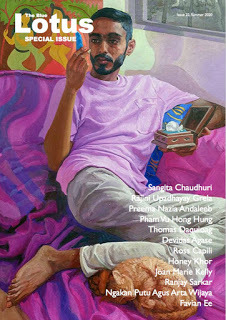
Two other stories from the same novel, one a short story, “Monkey Beach” and the other flash fiction “The Funeral Procession” were also published this year in The Secret Attic, a UK publication.
Recently I revised the 88,000-word novel and have been considering reverting it back to the previous title, The Woman on the Ferry, the first novel in a planned trilogy set in Penang. The second novel, in progress, will be The Lady on the Balcony. The third novel, already completed, The Girl in the Bathtub.
May 22, 2020
Neighbours: a Google Meet with UiTM—Penang
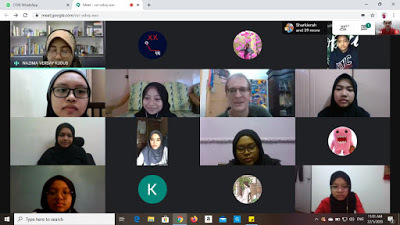
In every classroom, whether you are teacher or a student or an invited guest as I was yesterday, everyone should learn something. I learned one new skill, how to Google Meet, and two new words, membawang and kay poh chee!
I was invited by Nazima Versay Kudus into her on-line classroom, Integrated Language Skills II, at Universiti Teknologi MARA or UiTM—Penang (Bertam campus) via Google Meet to answer questions about my short story “Neighbours”, from my collection Lovers and Strangers Revisited, which they were studying. The sixty students were from the Faculty of Health Sciences.
This was my first time on Google Meet or any on-line forum during this Covid-19 MCO (Malaysian movement control order). In 2012 I did speak to students from Ohio University via Skype for their class on Exploring Malaysia’s Diversity through Film and Fiction, answering questions about two other stories from the same collection, “Only in Malaysia” and “Home for Hari Raya”. “Home for Hari Rara” was later filmed by Ohio University students who came all the way to Malaysia. Membawang, by the way, is a Malaysian slang for gossiping…like peeling layers of an onion, getting to the core of the truth, perhaps….Kay poh chee is a busybody. Both words are appropriate for “Neighbours” a story about a bunch of neighbors gossiping about the suicide of Johnny Leong. Mrs. Koh, who was once featured in a New Straits Times article, “Are You Mrs. Koh?” is your typical kay poh chee—a know-it-all busybody!
The students and I first talked about the neighborhood, how it was not typical of Malaysia for most Malaysians. Having lived in a new housing area that had recently opened to all Malaysians, I was given a unique perspective of Malaysia. Over time, as I found out, new neighborhoods start to skew in one direction or another. As more of one race move in, others start moving out. Eventually, it became a “Malay” area long after I moved away to a “Chinese” area closer to where I was teaching at Universiti Sains Malaysia in Penang.
Had I lived in a predominantly Malay neighborhood or a Chinese one or even an Indian one, my perspective of Malaysia would have been totally different...as it is now that I'm living in Sarawak! Fortunately, being new to Malaysia, I was not biased against one race or another. I judged them as I saw them, as we interacted—they were my neighbors!
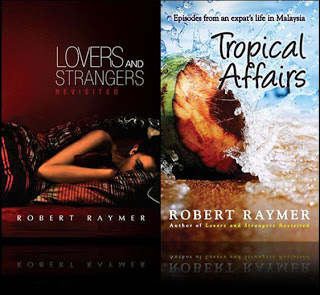
The question-and-answer session lasted one hour and the first two questions were, “Is the story real?” “Did it really take place?” I briefly talked about my neighbor committing suicide and my personal involvement and the choices I had to make, as I had written about in an earlier blog and later reprinted in Tropical Affairs: Episodes from an Expat’s Life in Malaysia.
Several questions veered away from the story, about writing in general, how to overcome writing slumps, what books I would recommend, what project am I working on now, and even how to be a good neighbor, but I would steer the conversation back to the story by pointing out aspects of “Neighbours” that they may have overlooked. I kept several questions handy just in case…like how did they interpret the story or what conclusions could they draw about the neighbors? (They really didn’t know each other very well.) How would someone who had never been to Malaysia perceive Malaysia, based on the story? (It’s multi-racial and the various races appeared to mix freely.)
What is the relevance of each character and what are their main concerns? Each character was, in fact, selfish in his own ways, concerned about their own ‘loss’ if the family moved away. The dentist would lose two more clients, the teacher would lose her ‘best’ student…
When I asked about Koh’s main concern, they merely compared him to his wife, so he seemed ok, but as an insurance salesman, he was upset that, if Johnny had bought life insurance, he didn’t buy it from him! He had asked Johnny several times!
I asked them, what was the significance of that last line by Mrs. Koh, when Tan asked “Who’s going to tell Veronica?” and she replied, “Not me! It’s none of my business!”
This was after she had made it very much herbusiness, making sure that each neighbor, as they joined the group, knew exactly what had happened (according to her), why it had happened (according to her), and what was wrong with each member of that family (according to her)! She had even insisted that Veronica was out gambling or spending all of her money on her daughter!
Later, one student asked, “Did Veronica actually go gambling or shopping?” Instead of giving the answer, I asked, “What does the evidence say?” Initially the student replied there was no evidence, but when I asked, “What were Veronica and her daughter Lily carrying at the end of the story?” Another student replied, “Shopping bags!” So, I asked, based on the evidence, did she go gambling or shopping? I wanted them to think! To look for clues in the stories that they read and draw their own conclusions.
Another question was, “Why did he kill himself (in the story) and also in real life?” So, I speculated over the financial implications, the fact that he sold his motorcycle and walked home. I also talked about how easy it is for someone to slip into depression when their world suddenly falls apart and drew parallels to the on-going Covid-19 virus, of people losing their jobs and finding themselves unable to pay their bills or to provide for their families. Unable to find a solution, they take the easy way out—easy for them, but painful for their survivors!
I also mentioned that, if they ever get into a difficult situation, that they should always look for a solution, to focus on the good aspects of life not just their current ‘bad’ situation, and that they are stronger than they think, and to never to give up! At times, we all need encouragement...
One of the last questions was “Did any of them tell Veronica?” and “Why did you stop the story short and not wait for Veronica to arrive?” I explained that the real story was about the neighbors themselves, their actions and their harsh words that reflected more on them than on Johnny’s suicide. And based on all of their excuses and their scattering before Veronica arrived, it left only Tan, the conscience of the story, to do the right thing. In the ‘real’ story, that fell to me, the newest neighbor, the foreigner, the white guy, who had to tell Johnny’s wife and daughter what had happened to Johnny.
When the hour was up, we said our goodbyes. Hopefully all of them came away with a deeper appreciation for the story and for the opportunity to pose questions to the author who had written it. (I would have loved to have that opportunity as a student!) I know I appreciated the opportunity of my being asked and sharing my insights on writing and on life itself, especially during this historic event that we are still in the midst of, not knowing how it will all turn out or how our families will be affected (including my own in America).
We can only keep our fingers crossed (or whatever Malaysians do for good luck) and hope that our neighbors remain healthy and safe (if not, they may infect us) and that they are not wasting their time gossiping about each other….The last thing we need during Covid-19 is another kay poh chee! One Mrs. Koh is quite enough!
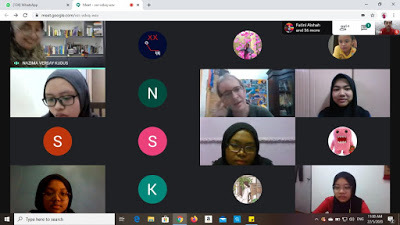
—Borneo Expat Writer
May 12, 2020
“The Funeral Procession” accepted by The Secret Attic, a British anthology
“The Funeral Procession”, a 1000-word excerpt from my novel A Perfect Day for an Expat Exit, has been accepted by The Secret Attic, a British anthology. It follows the acceptance of another excerpt, “Monkey Beech”, a full short story, taken from the same novel, accepted by the same publication last month.
So far, parts of five chapters have been published in six countries, fourteen times—all of chapters one and two, nearly all of chapters five and eleven, and part of chapter fifteen. One excerpt was even translated into French.
I have turned two other chapters into long short stories and several other parts into flash fiction. Even though this novel has never been published, mostly through my own stubbornness, since I had a chance to publish it in Singapore (and Malaysia) a really, really long time ago, I have held off and have been revising it every couple of years, including last year, where it was a finalist in the 2019 Faulkner Wisdom Novel Awards. (Also a finalist in 2017 & 2016.
Each publication from that novel shows me that I’m on the right track and bolsters its chances of being published in the US or UK, my desired markets, along with Malaysia and Singapore. I’ve been very patient. In fact, I have completed a sequel full of excerpts that I could no doubt publish when I get around to it…—Borneo Expat Writer
My interviews with four Malaysian novelists and one poet: Ivy Ngeow author of Cry of the Flying Rhino, winner of the 2016 Proverse Prize.Golda Mowe author of Iban Dream and Iban Journey.Preeta Samarasan author of Evening is the Whole Day.
Chauh Guat Eng author of Echoes of Silence and Days of Change. Also, Malachi Edwin Vethamani, author of Complicated Lives and Life Happens.
April 16, 2020
“Monkey Beach” accepted by Secret Attic, a British anthology, via a contest
It was impulsive. I admit it. In the Malaysian Writers Community, Tutu Dutta highlighted that it was the last day to enter the Secret Attic contest. The prize awarded was minimal 25 British pounds. No fee to enter, and since it was a new contest, I figured there wouldn’t be hundreds or thousands of entrants to compete against. She said they were hoping to reach 60, the reason for the last-minute push. They ended up with 78.
“What the hell,” I thought, and entered a novel excerpt set in Penang, titled “Monkey Beach”. In my rush, I failed to notice that they preferred under 1500 words. Naturally it didn’t win. To my surprise, however, I was one of ten chosen to be published—I wasn’t aware that was a possibility, an unexpected bonus. Two of the ten writers are from (or based in) Malaysia. The rest from the US, Canada, UK or Wales.
That’s the beauty of international contests, you get to test your writing skills against those from other countries. What may be ‘good’ in Malaysia or Turkey may not be so good in the UK. By good I mean...your story-telling ability and the high standard of writing and all that it implies. Having published short stories in all three of those countries (from my collection Lovers and Strangers Revisited—ten countries in all), I have a right to compare.
I admit I have not entered a short story contest in far too many years for various reasons (stories needed revision and I was concentrating on writing and revising novels). Entering writing contests was how I came to write those 15 stories in that original collection (now 17 stories). Back in the late 80’s, Malaysia had several major contests, The Star, Her World, New Straits Times (as an expat I could not enter).
“Neighbours”, originally titled “The Aftermath” was a consolation prize winner in The Star contest thirty-two years ago. By the way, during our Covid-19 lockdown, I have been asked to answer questions from the students at UITM next month via Google meet about that very story—still being taught!
The best thing about contests, besides the prospect of winning some serious money and the prestige, is the deadline! You either write and submit your story by the deadline or you miss out. Many of those stories that I wrote were rushed to meet that deadline and didn’t win. Of course not, they didn't stand a chance...they were rushed early drafts! But, and this is the point, they got written! I polished and entered them in future contests. After I had enough stories and a good publishing track record, I compiled them into a collection.
I have also been on the other end, as judge and have blogged about what judges look for. One caveat, entering contests can be expensive when converting local currency into dollars, pounds or euros. You must weigh the cost versus the benefit and your realistic chances of winning. If the contest (or an anthology accepting submissions) is free, you risk nothing, so go for it! Also, is there one winner or, perhaps, several? More winners, increases your odds. Are they publishing only the winner or are finalists considered for publication?
I admit that this contest that I entered was a pretty small. It’s new. It will grow. The biggest contest I ever entered had over two thousand entries. I sent in six stories, increasing my odds. Naturally I didn’t win. I won twice! Third prize, RM2,000 and a consolation prize, RM500.
So, enter those contests! Big and small—you never know. More importantly, get those stories written! Even though you may never win a contest you may have enough stories for a collection and, who knows, that collection itself might even win a contest! That’s what happened to me when Lovers and Strangers Revisited won the Star-Popular Readers’ Choice Awards. In addition to the money and the recognition, I received a pretty nice trophy for my efforts.

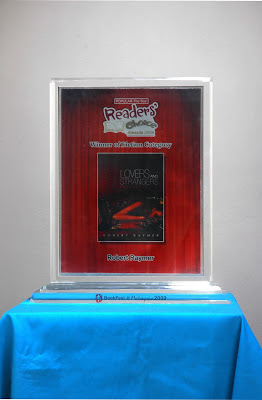
If you do win a contest, please think of me…and think of all those writers around the world who would love to be standing in your place. Remember, if you don’t enter, you cannot win!
Good luck and may the best story win!
--Borneo Expat Writer
My interviews with four Malaysian novelists and one poet:
Ivy Ngeow author of Cry of the Flying Rhino, winner of the 2016 Proverse Prize.
Golda Mowe author of Iban Dream and Iban Journey.
Preeta Samarasan author of Evening is the Whole Day.
Chauh Guat Eng author of Echoes of Silence and Days of Change.
Also, Malachi Edwin Vethamani, author of Complicated Lives and Life Happens.
Robert Raymer's Blog
- Robert Raymer's profile
- 3 followers


